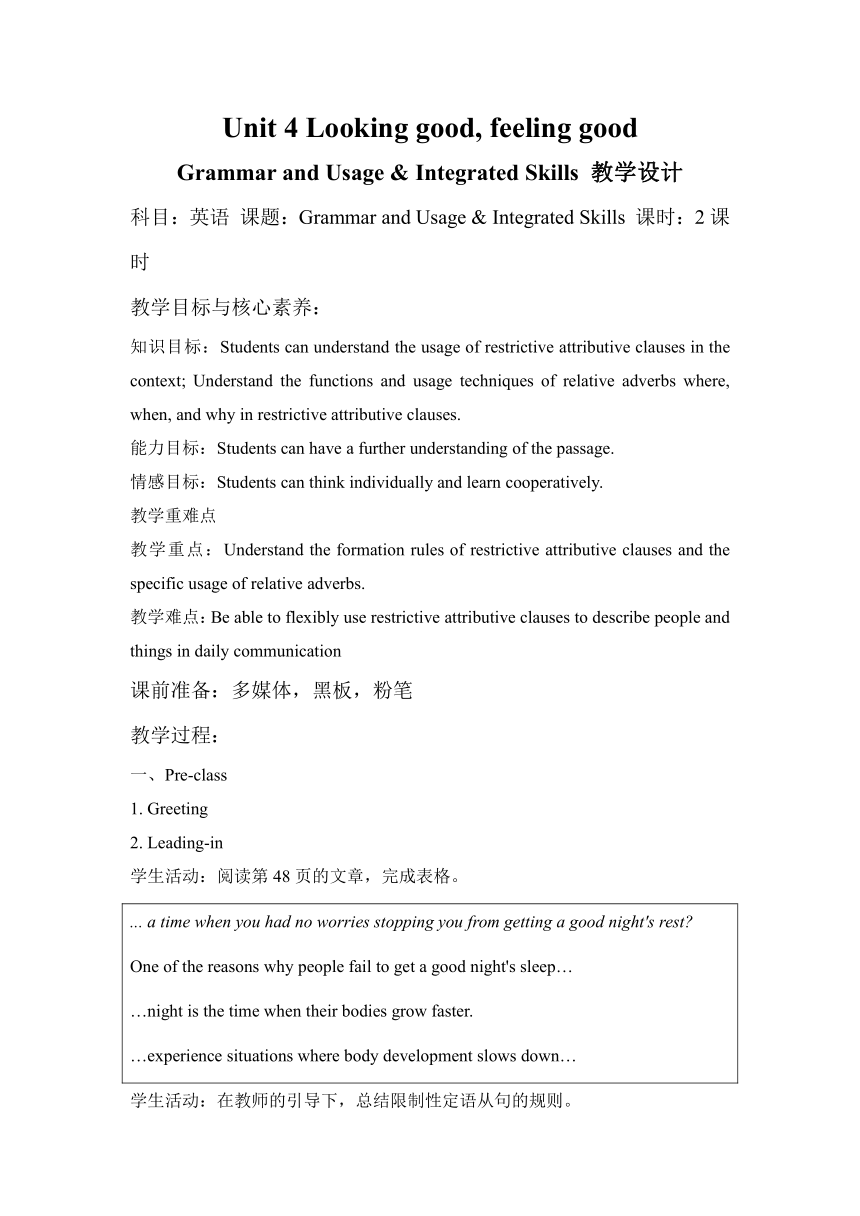
Unit 4 Looking good, feeling good Grammar and Usage & Integrated Skills 教学设计 科目:英语 课题:Grammar and Usage & Integrated Skills 课时:2课时 教学目标与核心素养: 知识目标:Students can understand the usage of restrictive attributive clauses in the context; Understand the functions and usage techniques of relative adverbs where, when, and why in restrictive attributive clauses. 能力目标:Students can have a further understanding of the passage. 情感目标:Students can think individually and learn cooperatively. 教学重难点 教学重点:Understand the formation rules of restrictive attributive clauses and the specific usage of relative adverbs. 教学难点:Be able to flexibly use restrictive attributive clauses to describe people and things in daily communication 课前准备:多媒体,黑板,粉笔 教学过程: 一、Pre-class 1. Greeting 2. Leading-in 学生活动:阅读第48页的文章,完成表格。 ... a time when you had no worries stopping you from getting a good night's rest One of the reasons why people fail to get a good night's sleep… …night is the time when their bodies grow faster. …experience situations where body development slows down… 学生活动:在教师的引导下,总结限制性定语从句的规则。 The relative adverb where refers to a place, the relative adverb when refers to (1) time, and the relative adverb why refers to (2) a reason. In more formal English, the relative adverbs where, when and why can be replaced by "preposition+ (3) which". 二、While-class 教师活动:详细介绍关系副词引导的限制性定语从句 一、定义 限制性定语从句是定语从句的一种,限制性定语从句对被修饰的先行词有限定制约作用,表现为先行词在意义上是不可缺少的定语,若省略,所修饰主句的内容就不完整或失去意义。这种从句和主句的关系十分密切,写时不可用逗号分开。 限制性定语从句由关系词(关系代词、关系副词)引导,其中关系副词用以修饰表示时间、地点或理由的先行词,在从句中作状语。 二、常见的关系副词 1.关系副词 where (1)where引导的定语从句的先行词往往是表示地点的名词(如place,room,house,spot,school,country等),在从句中作地点状语。 They went into the hall where the meeting was being held. 他们走进正在开会的大厅。 (2)where既可以引导限制性定语从句也可以引导非限制性定语从句。 Galileo lived in the city of Pisa, where there is a leaning tower about 180 feet high. 伽利略住在比萨城,那里有座大约180英尺高的斜塔。 (3)关系副词where常可用“介词(in/on/at/from…) +which”来代替。 The office where (at which) he works is not far from here. 他工作的办公室离这儿不远。 Japan is the place where (in which) earthquakes frequently happen. 日本是地震频繁爆发的地方。 (4)where有时还可用在“含有抽象地点意义的名词”后引导定语从句,如 relationship“在……关系中”,situation“在……情况下”,point“达到……程度”等,这些词虽然不是表示地点的名词,但在从句中表达的是“某个点或状态”的含义。 We have reached a point where a change is needed. 我们到了必须改一改的地步。 He got into a situation where it is hard to decide what is right and wrong. 他陷入一种难以分辨是非的局面。 辨析: where 引导的定语从句和状语从句的区别 引导定语从句 ... ...
~~ 您好,已阅读到文档的结尾了 ~~

